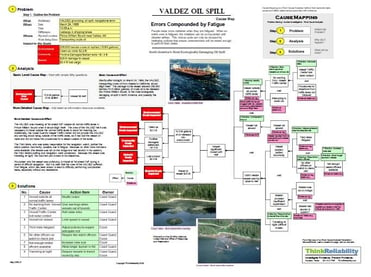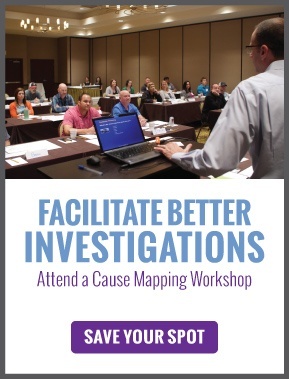When making a summary of an incident investigation, you are trying to summarize a large amount of information as concisely and clearly as possible. They say a picture is worth a thousand words, so what if instead of just writing sentences in a summary, you used pictures too?
Executive Summary Example
I could write an entire paragraph attempting to explain what I mean, but I think just showing you an example will more clearly communicate my point.
An incident investigation summary is often referred to as an executive summary, but a summary should be accessible to the frontline as well as executives. It should be clear to everyone.
If you are interested in learning more this example, you can read our Case Study of the Valdez oil spill, which includes a full-sized PDF version of the summary you can download.
1. Pack It with Information
This exact format may not perfectly fit your needs, but hopefully this one-page summary of the 1989 Valdez Oil spill gives you a sense for how much information can be communicated on a single piece of paper. You may not need to include the actual photos or both a basic and intermediate level Cause Map™ diagrams in an executive summary for your management, but a problem outline and an intermediate level Cause Map diagram could be extremely effective at describing an issue.
Creating an executive summary using a Cause Map diagram also tends to be quicker than writing a traditional executive summary. Depending on how a report will be used, a one-page summary that utilizes a Map may be all that is needed to convey the necessary information and a full report may not be required, which can save hours of work. Using Cause Map diagrams on an executive summary has the potential to save both the person preparing and the person reading a report significant time.
2. Define a Clear Problem Outline
If you would like to build a Cause Mapping® executive summary like the one above, I recommend you include a problem outline. Outlines help clearly define the problem by laying out the basic background information and listing out how the issue impacted your organization’s goals. Management or whomever reviews the executive summary can quickly identify the who, what, when and where for the issue. Plus, they can easily see the associated cost and other pertinent information, such as if there were any reportable injuries, an environmental release, a delay in production, etc.
3. Map Out the Details
Now that you’ve clearly defined the problem or issue, a Cause Map diagram may be used to describe the how of the issue. The Cause Mapping method visually lay out the cause-and-effect relationships to intuitively show what causes contributed to the issue. You can also include any important evidence under the relevant cause to show how the team came to their respective conclusions. Using a Cause Map diagram to summarize your investigation allows you to quickly communicate a large amount of information and is generally clearer than writing a paragraph that attempts to describe and summarize the same information.
4. Include Solutions
If the executive summary is for a completed investigation, solution boxes can also be included on the Cause Map diagram to show how the causes will be addressed to reduce the risk of reoccurrence. You can also include a solutions table like the one in the above example to list out all the solutions in one location, along with other useful information, such as the individual tasked to implement the solution(s) and the due date(s).
5. Utilize Resources
If a more graphical approach to an executive summary sounds like something you would like to try, you can download our free Cause Mapping template in Microsoft Excel and view this recording of our webinar “Executive Summary: Creating an Overview for Management” to help you get started.
If you’re one of our facilitation clients, just let us know if you would like an executive summary for your investigation, and we would be happy to create one for you.











